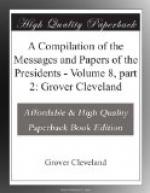A table presented by the Secretary of the Treasury showing the amount of money of all kinds in circulation each year from 1878 to the present time is of interest. It appears that the amount of national-bank notes in circulation has decreased during that period $114,109,729, of which $37,799,229 is chargeable to the last year. The withdrawal of bank circulation will necessarily continue under existing conditions. It is probable that the adoption of the suggestions made by the Comptroller of the Currency, namely, that the minimum deposit of bonds for the establishment of banks be reduced and that an issue of notes to the par value of the bonds be allowed, would help to maintain the bank circulation. But while this withdrawal of bank notes has been going on there has been a large increase in the amount of gold and silver coin in circulation and in the issues of gold and silver certificates.
The total amount of money of all kinds in circulation on March 1, 1878, was $805,793,807, while on October 1, 1889, the total was $1,405,018,000. There was an increase of $293,417,552 in gold coin, of $57,554,100 in standard silver dollars, of $72,311,249 in gold certificates, of $276,619,715 in silver certificates, and of $14,073,787 in United States notes, making a total of $713,976,403. There was during the same period a decrease of $114,109,729 in bank circulation and of $642,481 in subsidiary silver. The net increase was $599,224,193. The circulation per capita has increased about $5 during the time covered by the table referred to.
The total coinage of silver dollars was on November 1, 1889, $343,638,001, of which $283,539,521 were in the Treasury vaults and $60,098,480 were in circulation. Of the amount in the vaults $277,319,944 were represented by outstanding silver certificates, leaving $6,219,577 not in circulation and not represented by certificates.
The law requiring the purchase by the Treasury of $2,000,000 worth of silver bullion each month, to be coined into silver dollars of 412-1/2 grains, has been observed by the Department, but neither the present Secretary nor any of his predecessors has deemed it safe to exercise the discretion given by law to increase the monthly purchases to $4,000,000. When the law was enacted (February 28, 1878) the price of silver in the market was $1.204 Per ounce, making the bullion value of the dollar 93 cents. Since that time the price has fallen as low as 91.2 cents per ounce, reducing the bullion value of the dollar to 70.6 cents. Within the last few months the market price has somewhat advanced, and on the 1st day of November last the bullion value of the silver dollar was 72 cents.
The evil anticipations which have accompanied the coinage and use of the silver dollar have not been realized. As a coin it has not had general use, and the public Treasury has been compelled to store it. But this is manifestly owing to the fact that its paper representative is more convenient. The general acceptance and the use of the silver certificate show that silver has not been otherwise discredited. Some favorable conditions have contributed to maintain this practical equality in their commercial use between the gold and silver dollars; but some of these are trade conditions that statutory enactments do not control and of the continuance of which we can not be certain.




